When it comes to capturing sound with clarity and precision, the microphone is the cornerstone. But with a dizzying array of brands and models out there, declaring a single “best” microphone brand is misleading. The right answer depends heavily on your specific needs, budget, and even sonic taste.
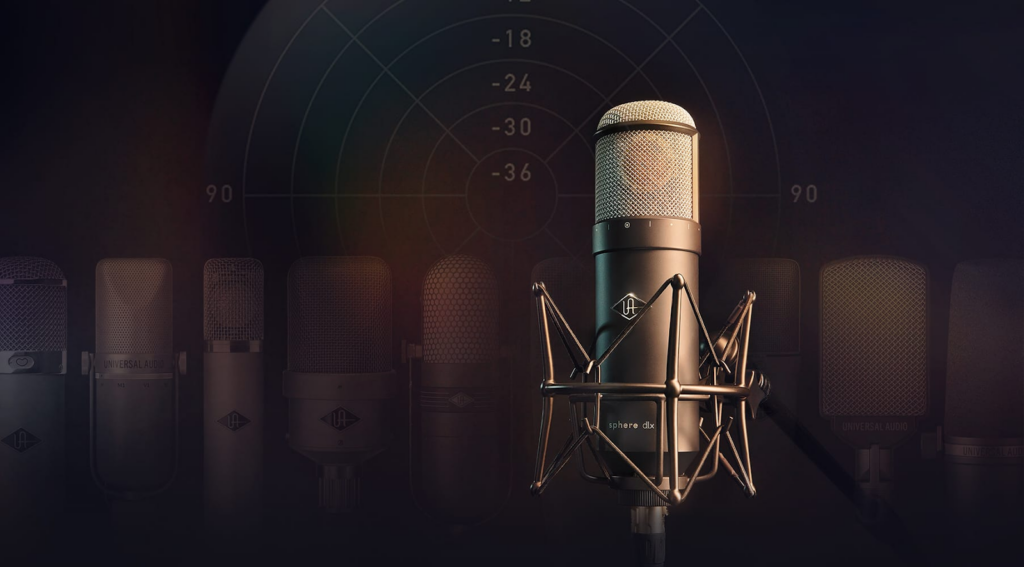
In this article, we’ll break down the strengths of top microphone brands and, more importantly, guide you through the factors to consider when making your decision. Are you ready?
Reviews for Best Brands of Microphones
The “best” brand is subjective. Different brands excel in different categories. Research individual models, listen to sound samples, and read reviews to find the mics that align with your needs and budget.
Shure
Shure Incorporated is an American company with a nearly century-long history in audio. Founded in 1925, it began as a supplier of radio parts and quickly grew into a leader in microphone technology. They have reliable audio performance products. The interesting thing is that their products have become industry standards.
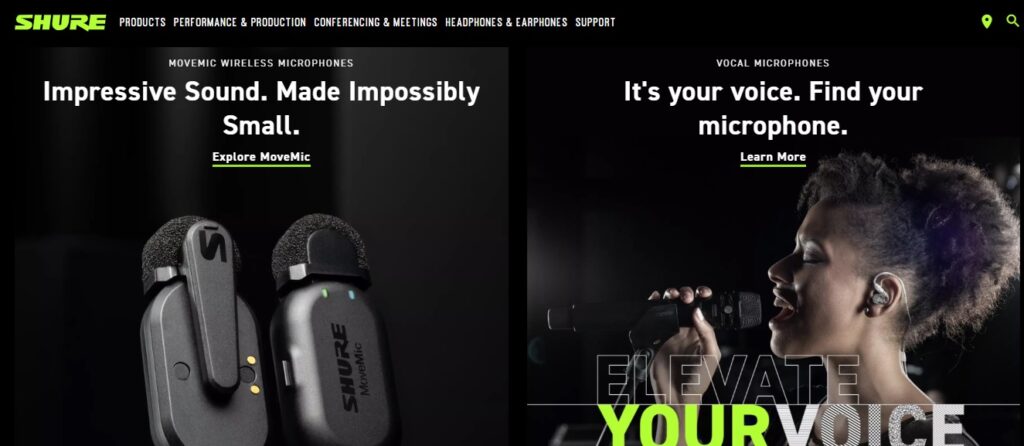
Features:
- Solid construction
- Good track record
- Versatile designs
- Mics designed for vocals (live and studio), various instruments, podcasting, broadcasting, and more
Shure’s Iconic Microphone Models
Below are the top models by Shure that you can own. Let’s have a closer look at them. Shall we?
SM58: Likely the most recognizable microphone in the world. This dynamic vocal mic is ubiquitous on stages for its clear sound, handling of loud volumes, and near-indestructible build.
SM57: The SM58’s sibling, designed for instrument miking. Versatile enough for everything from snare drums to guitar amps, it’s a staple in studios and live rigs.
Beta 58A: An upgraded SM58 with a slightly brighter response and supercardioid pattern for better background noise rejection. Popular with vocalists seeking a bit more presence.
SM7B: A legendary dynamic broadcast microphone beloved by radio hosts, podcasters, and vocalists who want a warm, rich, and detailed voice sound.
KSM8: Shure’s innovative dual-diaphragm dynamic vocal mic. Provides incredible control over proximity effect and off-axis sound, delivering studio-like detail in live settings.
Pros:
- Built like tanks: Shure mics, especially their live performance models, can handle drops, humidity, and the chaos of constant travel. They’re an investment in gear that won’t quit.
- Great ‘all-around’ sound: Shure mics focus on clarity and natural reproduction. While they may not have the hyper-detailed shimmer of some high-end studio mics, they reliably capture the essence of a sound source.
- Iconic models: The SM58 and SM57 are classics for a reason. They do their job well with a ton of versatility.
- Wide range: Shure offers everything from affordable USB mics for beginners to high-end wireless systems for touring professionals.
Cons:
- Not ’boutique’: Shure is less focused on the absolute pinnacle of sonic detail when compared to brands like Neumann. They prioritize value and performance.
- Can sound a bit ‘plain’: Some audio enthusiasts find their workhorse models lack a certain “wow” factor in the sound signature.
- Price varies: While some Shure models are surprisingly affordable, others inch closer to more specialized studio brands in price.
Hollyland
Hollyland has made a significant impact in the world of wireless microphones, catering to a wide range of content creators with their user-friendly and innovative audio solutions.
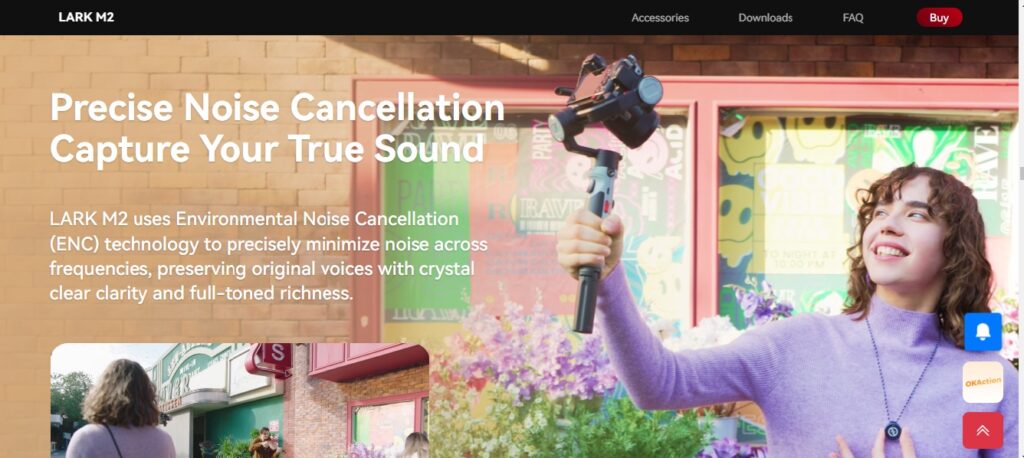
Features:
- Plug-and-play wireless systems
- Excellent sound
- Impressive battery
- Strong wireless designs
- Easy to use button microphone
Models
Below are some products to consider.
Hollyland Lark M1/M2: Fantastic all-around wireless lavalier systems perfect for vlogging, solo content creation, and interviews.
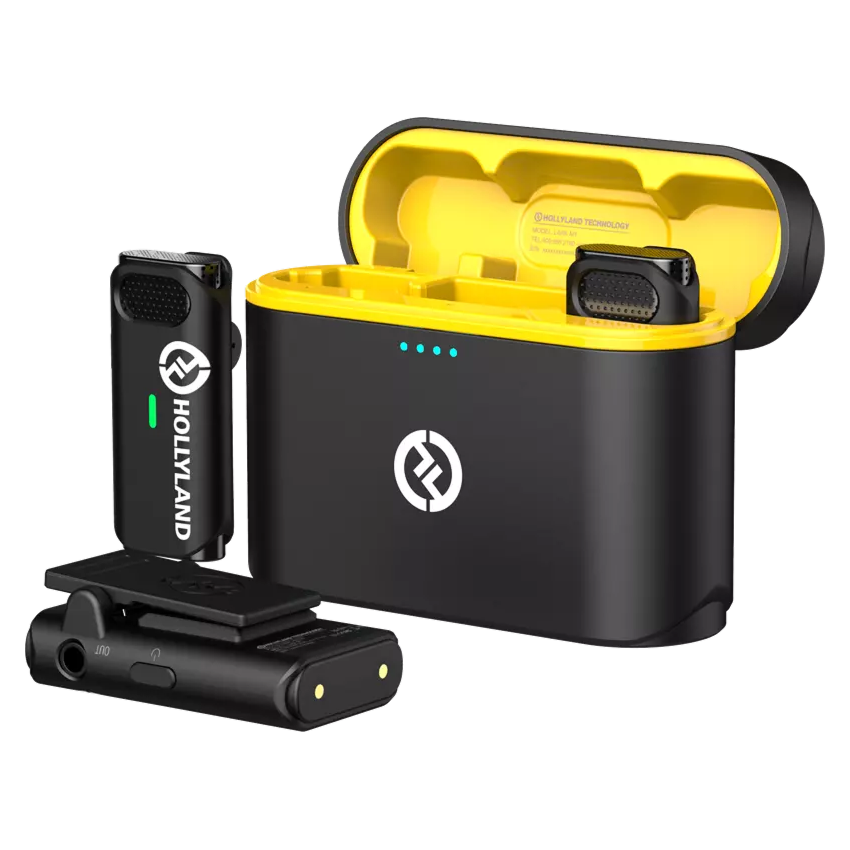
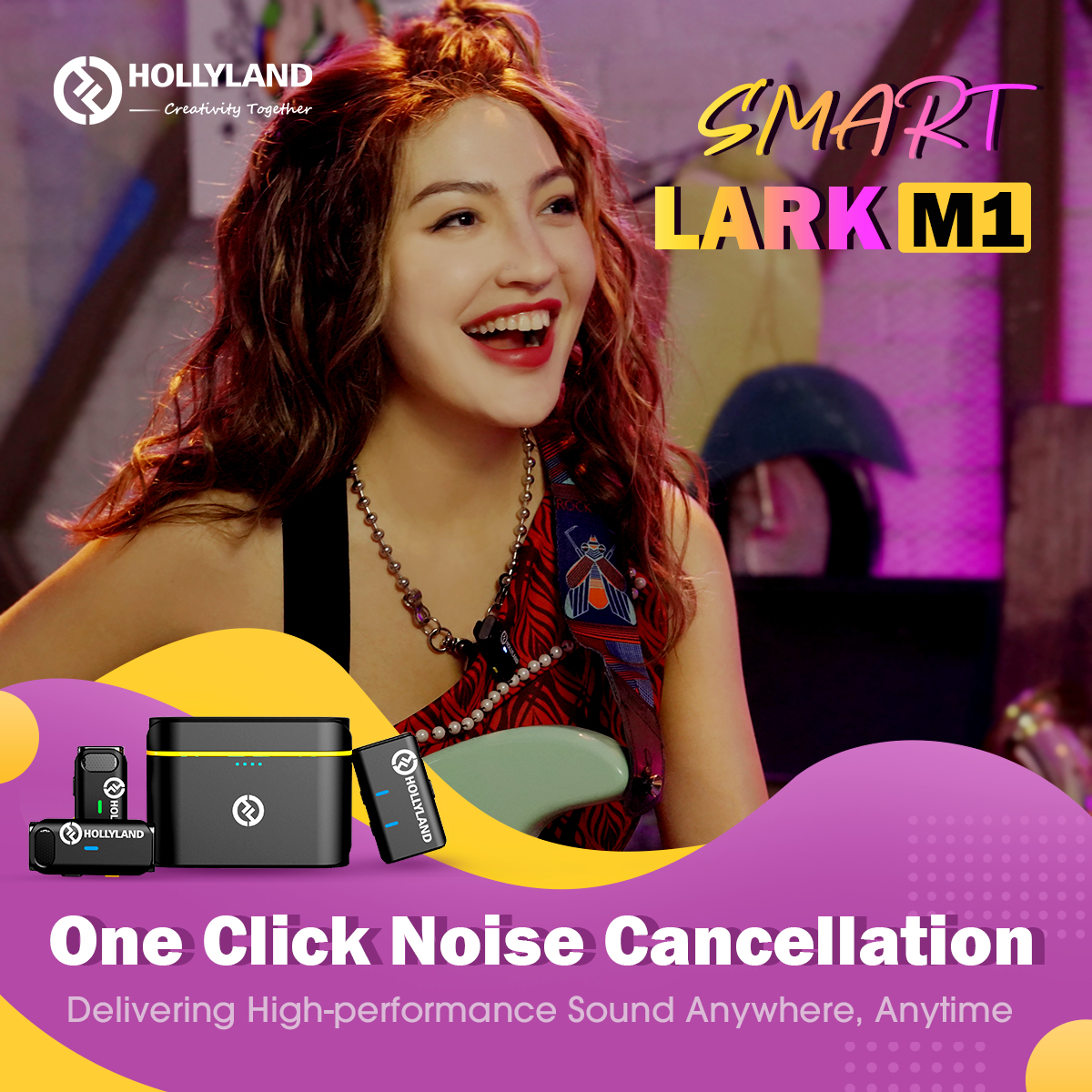
Hollyland LARK M1 - Tiny Wireless Microphone
A lightweight and user-friendly wireless microphone with one-click noise cancellation.
Key Features: Hi-Fi Sound Quality | Tiny & Light Design | Plug and Play
Hollyland Lark 150: Offers a longer range, professional XLR connections, and features ideal for more complex productions and studio environments.
Pros:
- User-friendliness: Hollyland systems are incredibly easy to set up and use. You’ll spend less time fiddling with settings and more time creating content.
- Excellent Sound Quality: Their mics provide clear audio with good noise reduction, ensuring your voice or instruments sound crisp and professional.
- Impressive Wireless Range: Their transmission distances allow for freedom of movement without fear of dropouts, making them great for run-and-gun style videos.
- Compact and Portable Design: The small size of their mics and receivers makes them perfect for travel vloggers or anyone needing a discreet audio setup.
- Innovative Features: Hollyland often includes unique features, like phone shutter control, that enhance functionality and set them apart.
Cons:
- Price: While competitive, Hollyland mics can be slightly more expensive than some budget-focused wireless microphone brands.
- Limited Stand Options: Hollyland focuses heavily on wireless lavalier mics, so you’ll need to adapt them to work with traditional microphone stands.
- Feature Specificity: Some features, like the phone shutter control, might not be essential for everyone.
Sennheiser
Founded in 1945, Sennheiser is a German audio company synonymous with high-quality sound. Their dedication to precision engineering and sonic accuracy has made them a favorite amongst audio professionals, musicians, and discerning listeners.
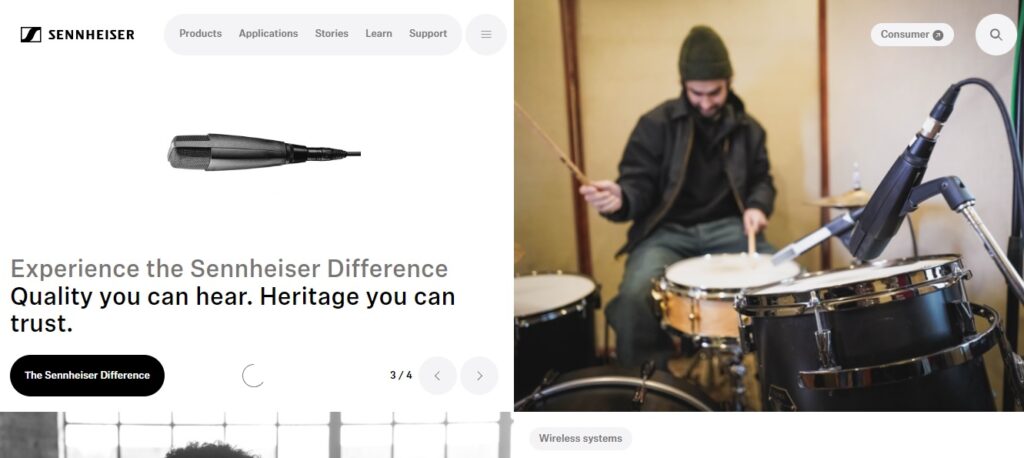
Features:
- Transparent sound
- Solid built and reliable
- Versatile range
- Wireless microphone technology
- Attention to details
Notable Sennheiser Microphone Models
Would you like to know about the top models this brand offers? We are sure the answer is yes.
MKH Series: Sennheiser’s revered shotgun microphones (like the MKH 416) are staples in film, broadcast, and nature recording for their focused sound pickup and rejection of off-axis noise.
MD 421: A highly versatile dynamic mic. Its warm sound and multi-position bass roll-off make it a favorite for vocals, drums, and broadcast applications.
Evolution Series: Wired dynamic mics designed for live vocals and instruments. Known for punchy sound, great feedback resistance, and stage-ready durability (ex: e835, e935)
e600 Series: Instrument microphones offering excellent detail and transient response, making them popular for drum recording.
Neumann Collaborations: Since acquiring Neumann Microphones, Sennheiser offers a range of these legendary high-end studio condensers.
Pros:
- Precision Engineering: Sennheiser microphones are known for their meticulously crafted German engineering, resulting in accurate and transparent sound reproduction.
- Wide Range: They offer an extensive catalog covering everything from studio condenser microphones to rugged stage dynamics, wireless systems, and even shotgun mics for filmmakers.
- High-End Quality: Sennheiser is a respected name for high-fidelity mics, especially in the studio realm where detail and nuance are paramount.
- Innovation: The brand continues to push boundaries with technologies like their AMBEO 3D audio capture and evolution wireless systems.
- Sound Signature: Sennheiser mics often have a slightly brighter, more ‘modern’ sound profile compared to the classic warmth of some other brands.
Cons:
- Premium Pricing: High-end Sennheiser microphones come with a high-end price tag, which may put them out of reach for budget-conscious users.
- Less Focus on ‘Iconic’ Models: While there are well-loved Sennheisers (HD series headphones, MKH 416), they don’t quite have the instantly recognizable status of some Shure classics like the SM58.
- Clinical Sound: The precision and detail Sennheiser is known for can sometimes be perceived as slightly clinical or less ‘characterful’ compared to mics from brands like Neumann or AKG.
Neumann
Georg Neumann GmbH, often referred to simply as Neumann, is a legend in the microphone world. Founded in 1928, this German company holds a near-mythical status for its role in shaping the sound of countless iconic recordings. Neumann mics embody precision, pristine detail, and often, a touch of sonic magic.

Features:
- Ultimate detail and nuance
- World-class sound
- Luxury class products
Neumann Iconic Microphone Models
Here, we have divided the models in categories, i.e., current models, broadcast line, live performance solutions, and some historical models.
Current Models:
TLM Series: Modern large-diaphragm transformerless mic line, known for wide frequency response and transparency.
TLM 102: Compact and affordable, great all-around studio workhorse.
TLM 103: Classic Neumann sound, highly popular for vocals.
TLM 107: Five polar patterns, excellent for flexibility.
TLM 193: Cardioid only, focuses on ultra-low noise.
M 149 Tube: Flagship tube condenser mic, modern with the classic Neumann sonic signature. Versatile and highly coveted.
U Series (U 47, U 67, U 87): Legendary studio microphones.
U 47 fet: Reissue of the classic U 47 with a field-effect transistor for slight modernization.
U 87 Ai: Current “standard” large-diaphragm condenser, found in top studios worldwide.
KM 180 Series: Small diaphragm condensers for precise instrument capture.
KM 184: Cardioid version, popular on acoustic instruments.
KM 185: Hypercardioid for pinpointed sound sources.
Broadcast Line:
BCM 705: Dynamic mic for broadcast with classic Neumann elegance.
BCM 104: Smaller version of the 705.
Solutions for Live:
KMS 104/105: High-end stage vocal condensers designed for loud environments.
Significant Historical Models
U 47, U 67: The most iconic tube-powered Neumann mics, heard on countless classic recordings. Original versions fetch high prices in the vintage market.
M 49, M 50: Earlier tube microphone designs, influential and prized for their character and warmth.
KM Series (older): KM 54, KM 84, etc. Vintage small-diaphragm condensers beloved for their sonic detail.
Pros:
- Legendary Sound Quality: Neumann is synonymous with high-end studio recording. Their microphones are revered for their unmatched detail, clarity, and ability to capture the finest sonic nuances.
- Iconic Models: The Neumann U87 is arguably the most famous studio condenser microphone ever, gracing countless iconic recordings. Other classics include the U47, U67, and the TLM series.
- Superb Craftsmanship: Neumann microphones are meticulously built in Germany with precision and longevity in mind. They represent an investment in quality.
- Sonic Character: While still detailed, many Neumann mics have a subtle ‘warmth’ or flattering quality that makes them particularly beloved for vocals and acoustic instruments.
- Prestige: Owning a Neumann microphone signifies a commitment to the highest audio standards and carries a certain degree of prestige within the industry.
Cons:
- High Price: Neumann microphones reside at the premium end of the market. Their top models can easily cost several thousand dollars.
- Requires a Good Environment: To fully reveal their magic, Neumann mics need an acoustically treated recording space and quiet preamps.
- Less Forgiving: The detail and precision of Neumann mics can highlight flaws in technique or a less-than-ideal recording room.
- Not ideal for All Applications: While versatile, they might not be the first choice for high-volume stage use or budget-constrained beginners.
Rode
Rode Microphones, an Australian company, has shaken up the microphone industry by offering excellent performance and build quality at prices that make pro-level tools accessible to a wider market. They cater particularly well to home studio owners, podcasters, independent filmmakers, and content creators.
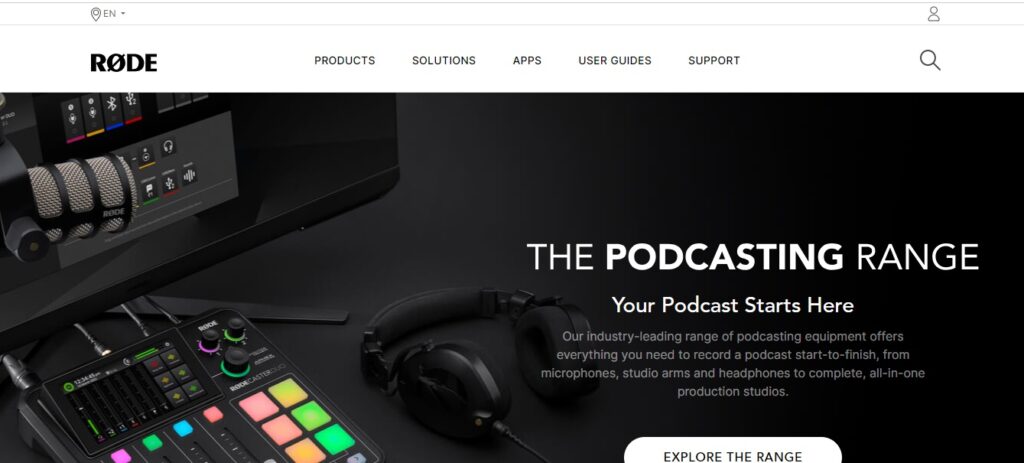
Features:
- Budget friendly products
- Tools available for podcasters, YouTubers, streamers, and more
- Plug-and-play simplicity
Rode Iconic Microphone Models
No, Rode is not left behind. Here also you will find excellent options.
NT-USB & NT-USB Mini: High-quality USB condenser microphones perfect for voiceover, streaming, and podcasting.
PodMic: Broadcast-style dynamic mic designed specifically for podcasting with a warm, clear sound.
VideoMic Series: Compact on-camera shotgun mics, ranging from smartphone-friendly to professional models.
Wireless GO Series: Ultra-compact wireless microphone systems ideal for vloggers, run-and-gun filmmakers, and interviewers.
NT1 & NT2-A: Versatile studio condenser microphones offering great value and performance.
Pros:
- Excellent Value: Rode delivers exceptional performance for the price, making them a famous choice for budget-conscious creators.
- Wide Variety: Rode offers mics for podcasters, musicians, filmmakers, home studios, and everything in between.
- Innovation: Rode consistently develops new technologies and form factors, like their USB microphones and the compact Wireless GO systems.
- User-Friendly: Many Rode mics are streamlined and easy to use, ideal for beginners or those who want to focus on content creation.
- Australian Company: While manufacturing takes place in China, Rode maintains its design and a portion of production in Australia.
Cons:
- Can lack ‘high-end’ detail: While perfectly suitable for their intended use, Rode mics generally won’t offer the extreme refinement of brands like Neumann or Sennheiser.
- Inconsistent Build Quality: Some lower-tier Rode models may feel less robust compared to pricier competitors.
- Less Characterful: Rode mics prioritize a clean, neutral sound. This can be an advantage, but users seeking mics with a unique sonic signature may look elsewhere.
- Less Established Prestige: While respected, Rode doesn’t carry the same weight of history as legacy brands like Shure or Neumann.
Audio-Technica
Founded in Japan in 1962, Audio-Technica (often shortened to A-T) has become a major player in the audio world. They are well-known for their headphones, phono cartridges, and of course, a massive range of microphones catering to almost any need and budget.
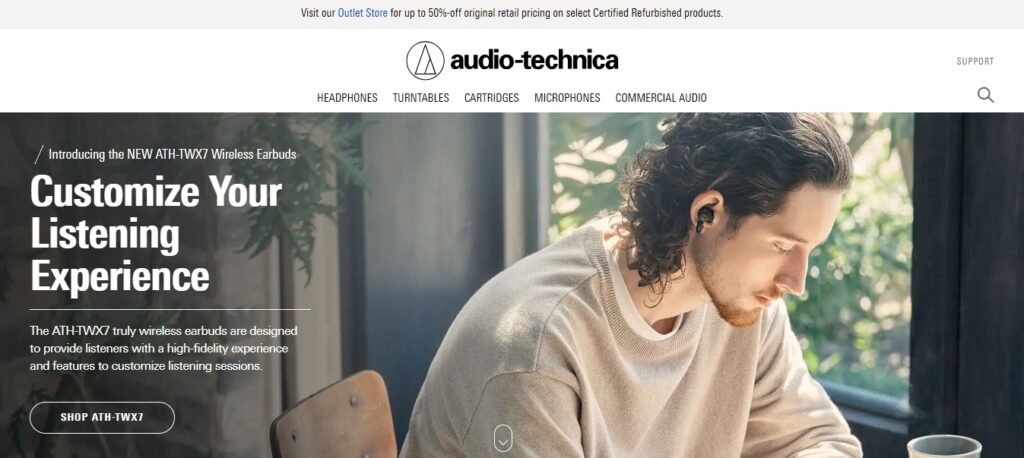
Features:
- The catalog is expensive and versatile
- Diverse solid quality
- A-T mics are known for their reliability, clear sound, and low self-noise
Audio-Technica Iconic Microphone Models
This brand has many series and all of them are mentioned below.
AT20 Series: This affordable condenser line shines for home studios, with models like the AT2020 (cardioid), AT2035 (multi-pattern), and USB versions.
AT40 Series: Higher-end studio condensers offering excellent detail and versatility, including the AT4040 and AT4050.
ATM Series: Workhorse dynamic mics ideal for live instrument and vocal miking.
AE Series: Well-priced instrument microphones designed for drums, guitar amps, and more.
BP40: Large-diaphragm dynamic microphone favored for its broadcast-friendly sound.
Pros:
- Price-to-Performance Ratio: Audio-Technica delivers excellent value, often punching above their price point in sound quality.
- Extensive Range: They offer microphones for virtually every need: vocals, instruments, podcasting, broadcasting, studio, and live use.
- Beloved Budget Choices: Models like the AT2020 and AT2035 have become staples for home studios and content creators due to their quality and affordability.
- Japanese Technology: Audio-Technica brings a commitment to reliable performance and innovation to their microphone designs.
- Some “Character” Options: While many Audio-Technica mics are neutral, they offer models like the AT4050 or AT4060 that bring a bit more distinctive sonic flavor.
Cons:
- Lacks Top-Tier Prestige: While respected, Audio-Technica generally isn’t the first brand considered for the most discerning high-end studio applications.
- Can Be Clinical: Some of their mics lean toward a very clean and neutral sound, which may lack the “magic” sought after by those who prefer a colored character.
- Huge Catalog: The sheer number of models can be overwhelming for beginners to navigate.
- Inconsistent Lower-End: Some of their cheapest options can feel flimsy or have less impressive sound quality.
Beyond the Brand: Factors to Consider
Before deciding which brand is best for you, just read about some important things you should consider before going on a shopping venture.
Microphone Type
- Dynamic: Rugged, good at handling loud sources, less sensitive to background noise. Great for live vocals, drums, and guitar amps.
- Condenser: More detailed and sensitive, capturing nuances and greater frequency range. Best for vocals and acoustic instruments in studio settings. Requires phantom power.
Polar Pattern
- Cardioid: Picks up sound mostly from the front, rejecting off-axis noise. Common for vocals and instruments.
- Omnidirectional: Captures sound equally from all directions. Great for room ambiance or multiple sound sources.
- Shotgun: Highly directional for pinpointing distant sound sources (e.g., film dialogue, bird sounds).
- Budget: Quality mics range from very affordable to high-end investments. Set a realistic budget before browsing.
- Intended Use: Are you a vocalist, podcaster, instrument player, or filmmaker? Your needs will guide your choice.
FAQs
What is the absolute best microphone brand?
There’s no single “best” as it depends on your needs and budget. Top brands include Shure, Sennheiser, Neumann, Rode, and Audio-Technica.
How much should I spend on a microphone?
This depends on your application. Decent beginner mics start around $100, mid-range is $200-$500, and high-end mics can reach several thousand dollars.
What factors should I consider when choosing a brand?
- Microphone Type (Dynamic vs. Condenser)
- Intended use (vocals, instruments, podcasting, etc.)
- Your budget
- Sound preference (clear and neutral? warm and characterful?)
Where can I find microphone reviews and comparisons?
Websites like Gear4Music, Sweetwater, and dedicated audio forums are good resources.
Final Thoughts!
The “best” microphone brand is the one that goes well with your needs and enables you to achieve the sound you’re envisioning. The names above are great starting points, but the true winner is found through a bit of research and understanding your own audio goals.


































.png)





